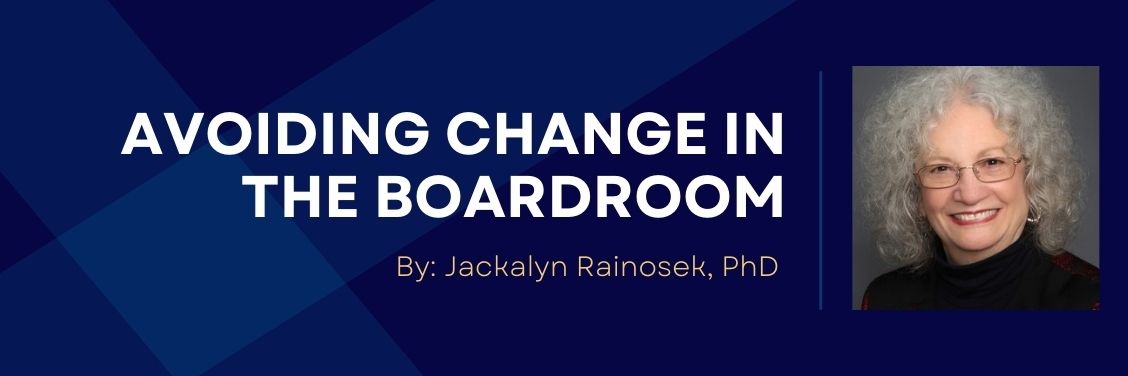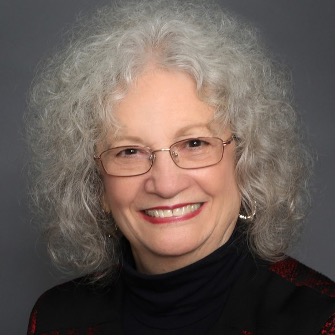
Questions to Ask in the Boardroom.
- What kinds of behaviors do you see in your board members that show they are resistant to change?
- How do they block efforts to diversify the board?
- Boards that function at a high level of performance are a high performing team. What would board members say about their team process?
Reasons Board Members Stay Stuck and Avoiding Change
For many years, I have found Mary Beth O’Neill’s book Executive Coaching with Backbone and Heart - A Systems Approach to Engaging leaders with Their Challenges to be a powerful and meaningful resource. She has the unique ability to put in one book many of the things a leader needs to know to move through blocks to change. She provides valuable information on how to address individual members or the board as an entity. When she discusses organizations and interactions in organizations, they are easily applied to a board. If you accept that a board is a team of people, then you will have no problem in learning from this book.
All kinds of things can happen in a system that may contribute to the members and the system itself not changing. This is equally true of a corporate board. The challenges can include all kinds of feelings people have about change that started in their original families and have been reinforced by them for years. The change can be prevented when people invest in what can be described as blocking techniques. I describe a broad range of blocking techniques in an article on my website. People who have uncomfortable feelings about conflict avoid investing in change.
No board chair has time to deal with all the styles of resistance they might encounter. A board that is stuck can learn how to get unstuck from the description in the section on homeostasis.
Homeostasis: The Systemic Problem in any Board
Social psychology teaches us that if we know how a system gets stuck then we can facilitate its change. In her book O’Neill points out that one of the ways in which a board can become stuck is to be trapped in a state of homeostasis. This is a set of conditions where the board has forces in the system that keep the current level of functioning intact. All boards have established patterns that are hard to change, and we often see these patterns when members want to invest in the status-quo. The current state of affairs for a board may be unstable and chaotic; yet the members will invest in this situation since the instability is familiar.
We often see this in boards that consistently fail to achieve their goals or stay in what O’Neill calls a “stable plateau.” She says, “homeostasis is like a well-functioning thermostat set to a specific temperature that resists change. It has a low tolerance for any variance in temperature.” Members of the board can continually refuse to have a “variance in temperature.” The more board members that are invested in maintaining the same circumstances, the harder it becomes to implement change.
Self-preservation of any system is a natural part of homeostasis. Sometimes when a board is not moving, we need to ask questions that could help identify their concerns and work through them. For example, investing in homeostasis can be connected to the survival of the board, since members may be concerned that if change occurs then the current level of functioning will be negatively impacted. The discussion of diversity can also result in people investing in homeostasis. Sadly, a board can be too slow to adapt to the changes needed for its survival.
As the Chair of a board, the reader might see people resist change even though they admit it will benefit the group. It can be challenging to experience “push back” or “don’t change” impulses from members. In these circumstances, understanding the power of homeostasis is invaluable. The key to working with the system in homeostasis is to identify the patterns that are emerging in the individual members and the board as a whole. When the Chair or members raise their ability to deal with conflict then all individuals involved will move to a calmer place and be able to discuss or ask questions that will help identify where the resistance exists.
This is not a time for judgment or impatience. It is a time for respectful discussion. For example, I was a consultant for a board where the board members were open to change but the board chair was not. The board members and the executive director hired me to work with the board and implement the desired changes. I asked to speak with the board President and through that discussion he agreed to allow me to help him with his resistance to change.
Methods for Moving to Support Change
One of my short programs is entitled, “Change is a Process Not an Event.” People who resist change see the change as a monumental experience that they have to go through that will be painful. If the board Chair or members can present the idea that every change has a number of steps or events that will occur, and then have the chance to talk about each step, then individuals may become less resistant to change. Planning for change and creating a step-by-step process for the change will increase support for the change.
Mark Connelly took Kurt Lewin’s ideas and put them into a short paper called The Kurt Lewin Change Management Model. In this paper he quotes a statement from Kurt Lewin about change: “Transition is the inner movement or journey we make in reaction to a change.” Change really is continually transitioning until coming to a place of less change. Explaining change as transitioning assists members of boards to be more receptive to discussing a subject like diversity that will lead to change.
There are two important aspects of emotions that may be included in the discussion of change: First, each board member will need to identify and process through their feelings as they go through the change process; and second, they will have thoughts that occur as they feel their feelings and they will need to process through the thoughts as well. If they do not process their feelings about their thoughts, then they will contribute to conflict and/or make decisions that will not lead to solutions. Lewin indicates that we do need to recognize that change is necessary; therefore, we have to unfreeze ourselves and “move toward a new way of living.”
All of us have been through many changes in our lives. Questions about the number of changes, and what they were, can help members work through the need for change. Some examples of questions are: How many of you have changed jobs at least two or more times in your professional career? What are the changes going on in the organizations that you work for and what do you do to help yourself move through the changes? There have been many changes in the last few years for all of us. How did you manage these changes and what were they? The board can consider what changes have been made by the board and what the challenges and benefits for those changes were.
One of my favorite statements that I use in talking about change is “There is no pain in change. The pain comes from the resistance to change.” Each of us creates our own pain when we are resistant to having meaningful discussion about what needs to change to diversify a board.
More Questions for Board Members to Consider
- After the board members read the list of blocking techniques provided in this article, what blocks would they own that are a part of their behavior?
- How do their blocking behaviors prevent changes to diversify the board?
- After considering the section on homeostasis, what do you see in the board that shows homeostasis exists in the board?
- Change is a process that is constant. What can board members do to move through changes and stop resisting change in the board?

ABOUT JACKALYN RAINOSEK, PHD
Dr. Jackalyn Rainosek is CEO and Co-Founder of DTP Leadership Group, as well as founder and principal of DTP Business Strategies. She has worked extensively with a wide range of Leaders as they make strategic decisions in ever-changing circumstances to achieve extraordinary results and increase profitability. As a senior business consultant and marketing strategist Dr. Rainosek works with business owners and corporate executives to generate optimal results and exponential growth. Dr. Rainosek guides organizations to develop more appropriate leadership styles, enhance cultural competency (through diversity, equity, and inclusion initiatives), and improve levels of trust and cooperation both internally and with the customer base
